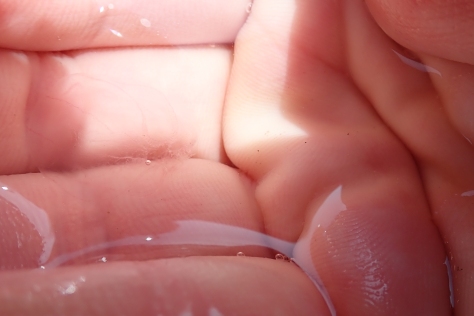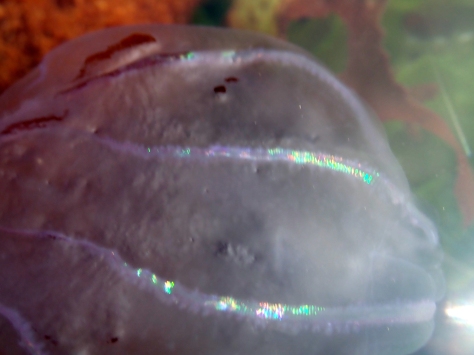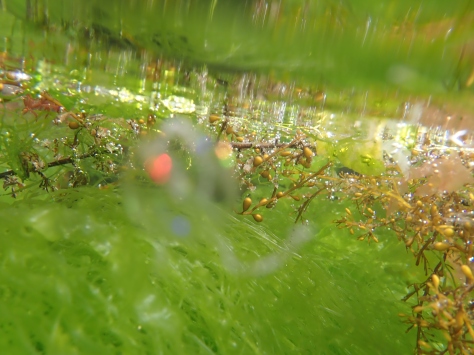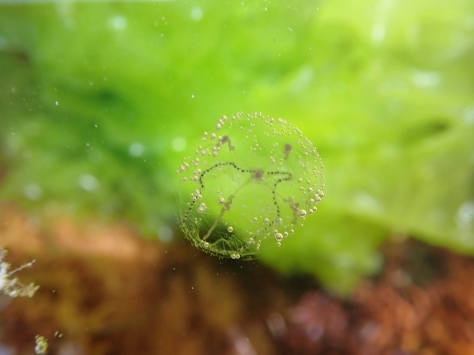I should be at home, cracking on with some work, but I’ve heard there are comb jellies about and I could do with some photos for my jellyfish course for ERCCIS.
Any excuse.
I cut through overgrown vegetation, down the cliff path to a favourite cove. In the ten minutes it’s taken me to walk here, the grey clouds have lifted and the sea’s looking good enough to dive into.
My progress through the rocky gully is slow. The warm weather has brought an explosion of slippery sea lettuce which blocks my view of my feet as they feel for underwater rocks. Tangles of pink spaghetti, the eggs of sea hares, are wrapped around many of the green fronds and a close inspection reveals that dozens of stalked jellyfish (Haliclystus octoradiatus) have already made their homes here.
As I move into deeper water, something catches my eye, floating below the surface. It’s so transparent it’s barely there, but it shimmers intermittently. With some difficulty, the current swishing the jelly back and forth, I scoop it up and carry it in cupped hands to a sheltered overhang. For a moment I think I’ve dropped it, then it swims out.

I’m treated to a fabulous display of iridescence as the comb jelly beats its tiny combs, sending a trail of light and colour up the lines on its tiny body.
Between the current washing into the pool and the jelly’s own surprisingly speedy swimming efforts, it slips away each time I come close to getting it under the camera. To add to the fun, my camera can’t see it. I take a whole series of photos of nothing. The perfect transparency of the animal means I can only focus on the seaweed below.

When another comb jelly washes into the pool, I’m sure there will be lots more opportunities to attempt photos. Stepping out into the open water, I take some time to accustom my eyes, staring past the surface reflection into the water. Soon, I notice comb jellies everywhere.

There are dozens, hundreds even, and some are large enough to fill the palm of my hand. Even the large jellies pose a challenge to my camera, but amongst the many seaweed shots, I start to take a few that show off the jellies’ light display.
While most are the large species, Beroe cucumis, with their characteristic sack shape, there are a few smaller ones amongst them. These are sea gooseberries, Pleurobrachia pileus. They are barely a couple of centimetres long, spherical, with two trailing tentacles.

Despite their tiny size, they are just as mesmerising as the B. Cucumis, the lines down their sides flickering every colour of the rainbow.

Among all the comb jellies I spot an even smaller interloper, a hydroid medusa. Hydroids are related to jellyfish, but their adult form usually lives attached to seaweeds, stones or shells. This minute creature is a baby hydroid, looking very much like a jellyfish as it actively swims past, beating its bell fringed with short tentacles.

The pattern of the cross on top of it and the fringe of dark spots around the edge of the bell suggest that it is a young Clytia hemispherica.

The glare of sunlight on my screen combined with the transparency of all the animals I’m trying to photograph make it impossible to tell how I am doing. I give up taking photos and simply enjoy the spectacle until the tide calls time and forces me back up the beach.
Comb jellies are supposed to phosphoresce, which would be amazing to see. I’m wondering if I can sneak in a little night time rockpooling this weekend. Although the jellies are here in huge numbers today, they may disappear as quickly as they arrived. I should be working, but some things are just too exciting.


Amazing.
Will the ERCCIS course mean you have to say the word Ctenophore in public?
LikeLiked by 1 person
Probably… if I have to cover hydroids I’ll probably also have to say gonotheca too! 😀
LikeLike
Fiendishly difficult to photograph. Well done. Used to see a lot of sea gooseberries washing up on sandy beaches. Great post.
LikeLiked by 1 person
They are tricky – I couldn’t begin to capture how mesmerising they were on my little camera. I’ll try again if there are some around today but I’m happy just to have seen them. Like you, I’ve tended to see them on beaches sometimes, so very exciting to see the live animal. 🙂
LikeLike
Thank you , these are fascinating creatures. Great photos too. Will be on the lookout next time I’m in the West Country.
LikeLiked by 1 person
Thank you – they’re definitely worth looking out for 🙂
LikeLike